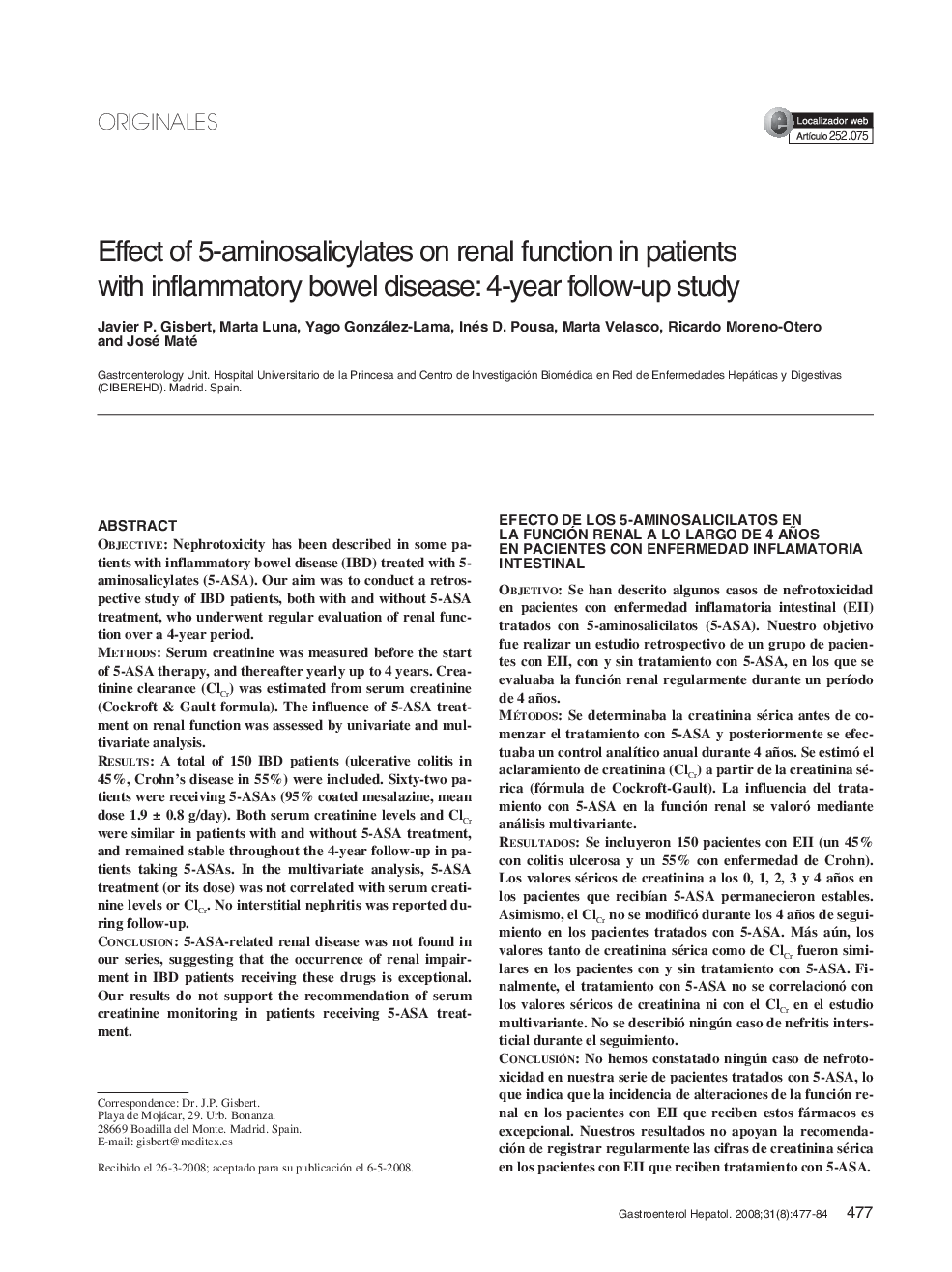| Article ID | Journal | Published Year | Pages | File Type |
|---|---|---|---|---|
| 3288719 | Gastroenterología y Hepatología | 2008 | 8 Pages |
ObjectiveNephrotoxicity has been described in some patients with inflammatory bowel disease (IBD) treated with 5-aminosalicylates (5-ASA). Our aim was to conduct a retrospective study of IBD patients, both with and without 5-ASA treatment, who underwent regular evaluation of renal function over a 4-year period.MethodsSerum creatinine was measured before the start of 5-ASA therapy, and thereafter yearly up to 4 years. Creatinine clearance (ClCr) was estimated from serum creatinine (Cockroft & Gault formula). The influence of 5-ASA treatment on renal function was assessed by univariate and multivariate analysis.ResultsA total of 150 IBD patients (ulcerative colitis in 45%, Crohn's disease in 55%) were included. Sixty-two patients were receiving 5-ASAs (95% coated mesalazine, mean dose 1.9 ± 0.8 g/day). Both serum creatinine levels and ClCr were similar in patients with and without 5-ASA treatment, and remained stable throughout the 4-year follow-up in patients taking 5-ASAs. In the multivariate analysis, 5-ASA treatment (or its dose) was not correlated with serum creatinine levels or ClCr. No interstitial nephritis was reported during follow-up.Conclusion5-ASA-related renal disease was not found in our series, suggesting that the occurrence of renal impairment in IBD patients receiving these drugs is exceptional. Our results do not support the recommendation of serum creatinine monitoring in patients receiving 5-ASA treatment.
ObjetivoSe han descrito algunos casos de nefrotoxicidad en pacientes con enfermedad inflamatoria intestinal (EII) tratados con 5-aminosalicilatos (5-ASA). Nuestro objetivo fue realizar un estudio retrospectivo de un grupo de pacientes con EII, con y sin tratamiento con 5-ASA, en los que se evaluaba la función renal regularmente durante un período de 4 años.MétodosSe determinaba la creatinina sérica antes de comenzar el tratamiento con 5-ASA y posteriormente se efectuaba un control analítico anual durante 4 años. Se estimó el aclaramiento de creatinina (ClCr) a partir de la creatinina sérica (fórmula de Cockroft-Gault). La influencia del tratamiento con 5-ASA en la función renal se valoró mediante análisis multivariante.ResultadosSe incluyeron 150 pacientes con EII (un 45% con colitis ulcerosa y un 55% con enfermedad de Crohn). Los valores séricos de creatinina a los 0, 1, 2, 3 y 4 años en los pacientes que recibían 5-ASA permanecieron estables. Asimismo, el ClCr no se modificó durante los 4 años de seguimiento en los pacientes tratados con 5-ASA. Más aún, los valores tanto de creatinina sérica como de ClCr fueron similares en los pacientes con y sin tratamiento con 5-ASA. Finalmente, el tratamiento con 5-ASA no se correlacionó con los valores séricos de creatinina ni con el ClCr en el estudio multivariante. No se describió ningún caso de nefritis intersticial durante el seguimiento.ConclusiónNo hemos constatado ningún caso de nefrotoxicidad en nuestra serie de pacientes tratados con 5-ASA, lo que indica que la incidencia de alteraciones de la función renal en los pacientes con EII que reciben estos fármacos es excepcional. Nuestros resultados no apoyan la recomendación de registrar regularmente las cifras de creatinina sérica en los pacientes con EII que reciben tratamiento con 5-ASA.
